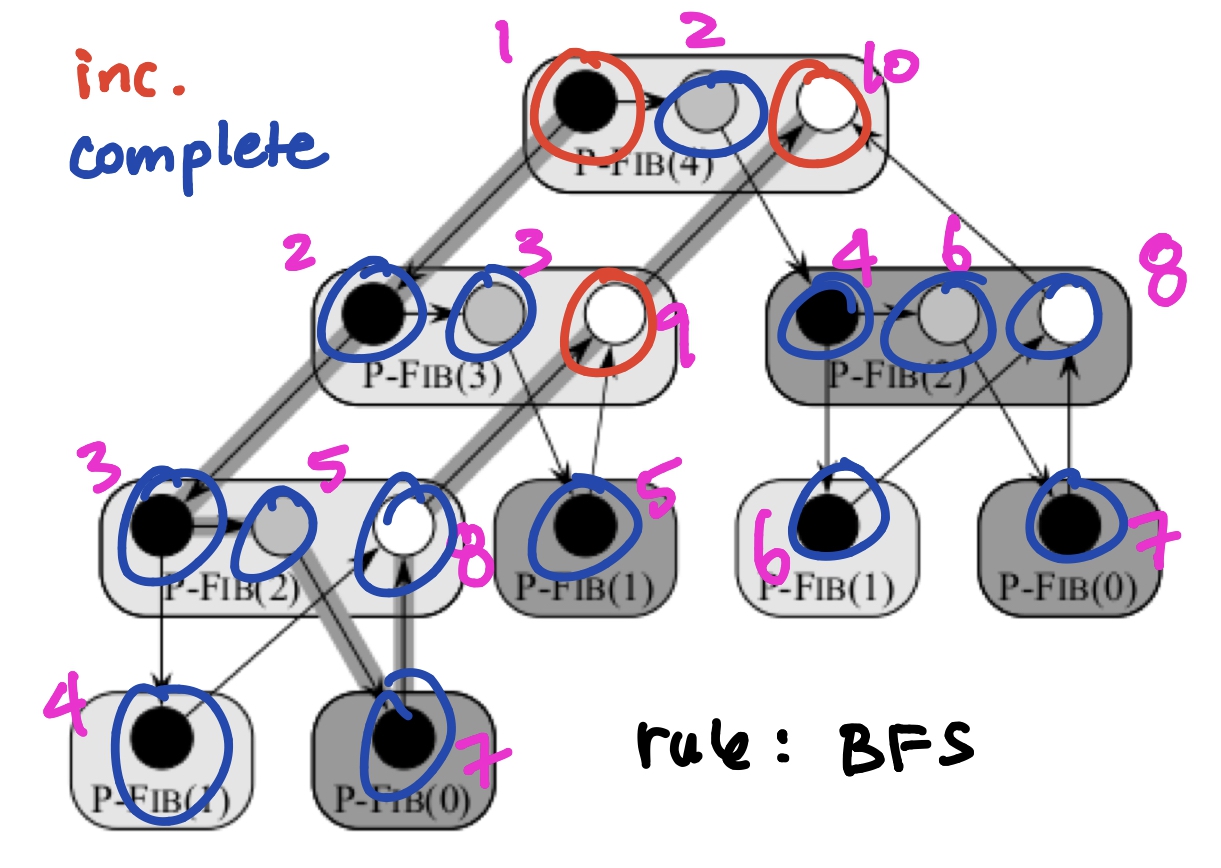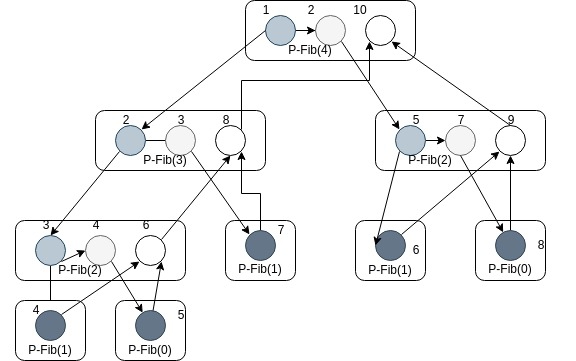2019-02-12
Feb 13 In-Class Exercise Thread.
Hey Everyone,
Post your solutions to the Feb 13 In-Class Exercise to this thread.
Best,
Chris
Hey Everyone,
Post your solutions to the Feb 13 In-Class Exercise to this thread.
Best,
Chris
Suppose we were to run P-Fib(4) whose execution graph we saw last day on two processors.
What would be the maximum run time according to Brent/Blumofe Leirsons's theorem?
``
Solution: Brent/Blumofe Leirsons's theorem provides an upper bound of `T_P\le T_1/P + T_\infty`. Given that `P=2, T_1 = 17`, and `T_\infty = 8`, the upper bound for `T_2` is given by `T_2\le 17/2+8 = 16.5`.
Mark up the graph with the complete and incomplete steps.
``
Solution: Using a DFS rule for the greedy scheduler,
Using a BFS rule for the greedy scheduler,
How many steps does the computation actually take?
``
Solution: Because `T_1 = 17`, given that we have 3 incomplete steps (1 strand each), we will have 7 complete steps (2 strands each). Therefore the total number of steps is 10 steps.
(Edited: 2019-02-15) ''Suppose we were to run P-Fib(4) whose execution graph we saw last day on two processors.''
----
''What would be the maximum run time according to Brent/Blumofe Leirsons's theorem?''
@BT@@BT@
'''Solution: ''' Brent/Blumofe Leirsons's theorem provides an upper bound of @BT@T_P\le T_1/P + T_\infty@BT@. Given that @BT@P=2, T_1 = 17@BT@, and @BT@T_\infty = 8@BT@, the upper bound for @BT@T_2@BT@ is given by @BT@T_2\le 17/2+8 = 16.5@BT@.
----
''Mark up the graph with the complete and incomplete steps.''
@BT@@BT@
'''Solution: '''Using a DFS rule for the greedy scheduler,
((resource:IMG_0170.jpg|Resource Description for IMG_0170.jpg))
Using a BFS rule for the greedy scheduler,
((resource:IMG_2DEF148FC217-1.jpeg|Resource Description for IMG_2DEF148FC217-1.jpeg))
----
''How many steps does the computation actually take?''
@BT@@BT@
'''Solution: ''' Because @BT@T_1 = 17@BT@, given that we have 3 incomplete steps (1 strand each), we will have 7 complete steps (2 strands each). Therefore the total number of steps is 10 steps.
Resource Description for Feb 11, 2019 (1).jpg
Max running time by Brent's: max time <= T_1 / P + T_infinity = 17 / 2 + 8 = 16.5
max running time is 16.
Actually, it takes 10 steps. Step 1, 9, 10 are incomplete steps.
(Edited: 2019-02-13) ((resource:Feb 11, 2019 (1).jpg|Resource Description for Feb 11, 2019 (1).jpg))
Max running time by Brent's: max time <= T_1 / P + T_infinity = 17 / 2 + 8 = 16.5
max running time is 16.
Actually, it takes 10 steps. Step 1, 9, 10 are incomplete steps.
2019-02-13
What would be the maximum run time according to Brent/Blumofe Leirsons's theorem?
TP≤T1P+T∞ = 17/2 + 8 = 33/2
The computation take 11 steps. Step 1, 7, 9, 10, 11 are incomplete steps.
(Edited: 2019-02-13) What would be the maximum run time according to Brent/Blumofe Leirsons's theorem?
TP≤T1P+T∞ = 17/2 + 8 = 33/2
((resource:fib.png|Resource Description for fib.png))
The computation take 11 steps. Step 1, 7, 9, 10, 11 are incomplete steps.
2019-02-15
Suppose we were to run P-Fib(4) whose execution graph we saw last day on two processors.
What would be the maximum run time according to Brent/Blumofe Leirsons's theorem?
T1 = 17, T(infi) =8 T(max)<=17/2 +8 = 33/2
Mark up the graph with the complete and incomplete steps. Make as small an image of this as legibly possible.
How many steps does the computation actually take?
It takes 10 steps of which 1, 9 and 10 are incomplete
(Edited: 2019-02-15) Suppose we were to run P-Fib(4) whose execution graph we saw last day on two processors.
What would be the maximum run time according to Brent/Blumofe Leirsons's theorem?
T1 = 17, T(infi) =8 T(max)<=17/2 +8 = 33/2
Mark up the graph with the complete and incomplete steps. Make as small an image of this as legibly possible.
((resource:Untitled Diagram (4).jpg|Resource Description for Untitled Diagram (4).jpg))
How many steps does the computation actually take?
It takes 10 steps of which 1, 9 and 10 are incomplete
Based on Brents's Algorithm T_{P} <= T_{1}/P + T_{infinity}
T_{1} = 17, P = 2, T_{inf} = 8
17/2 + 8 = 17/2 + 16/2 = 33/2
Steps 1, 9, and 10 were incomplete.
(Edited: 2019-02-16) ((resource:Untitled.png|Resource Description for Untitled.png))
Based on Brents's Algorithm T_{P} <= T_{1}/P + T_{infinity}
T_{1} = 17, P = 2, T_{inf} = 8
17/2 + 8 = 17/2 + 16/2 = 33/2
Steps 1, 9, and 10 were incomplete.
2019-02-16
((resource:In-class-02_13-converted.pdf|Resource Description for In-class-02_13-converted.pdf))
2019-02-17
1) Maximum run time according to Brent's theorem T_p <= (T_1 / P) + T_inf T_1 = 17, P = 2, T_inf = 8 T_p <= 17/2 + 8 T_p <= 33/2 2) 10 steps
 (Edited: 2019-02-17)
(Edited: 2019-02-17) <pre>
1) Maximum run time according to Brent's theorem
T_p <= (T_1 / P) + T_inf
T_1 = 17, P = 2, T_inf = 8
T_p <= 17/2 + 8
T_p <= 33/2
2) 10 steps
</pre>
((resource:image1.jpg|Resource Description for image1.jpg))
1. Maximum runtime
T1 = 17, Tinf=8, P=2.
Tmax <= (T1)/P + Tinf = 17/2 + 8 = 33/2
2. How many step?
10 steps.
Resource Description for capture.JPG
(Edited: 2019-02-18) 1. Maximum runtime
T1 = 17, Tinf=8, P=2.
Tmax <= (T1)/P + Tinf = 17/2 + 8 = 33/2
2. How many step?
10 steps.
((resource:capture.JPG|Resource Description for capture.JPG))
(c) 2025 Yioop - PHP Search Engine






